There are people who go winter camping in the snow. People like climate researchers have been known to camp in the Antarctic. For these extreme adventurers, it is never too cold to go camping…
But what about the rest of us- How cold is too cold to go tent camping? And what about if you don’t have good gear?
The quick answer is this:
Nighttime temperatures in the high 30s/low 40s Fahrenheit are too cold for tent camping for inexperienced campers with cheap gear. Nighttime temperatures of about 50°F to 65°F are most comfortable for tent camping.
This doesn’t mean you shouldn’t go camping in cold weather though! However, you do need to be prepared. This guide will go over everything you need to know, including gear requirements, how to stay dry, how to calculate nighttime temperatures, and other tips.
Contents:
- What Gear Do You Need to Camp in the Cold?
- The Importance of Staying DRY when Camping in the Cold
- How Cold Will It Get Camping? (How to Calculate Temperatures)
- Camping in 20, 30 and 40 Degree Temperatures
- Tips for Camping in Cold Weather
What Gear Do You Need to Camp in the Cold?
If you want to go camping in cold weather, you will need the right gear. This includes:
- Suitable tent
- Warm sleeping bag
- High R-value sleeping pad
- Clothing which won’t make you sweat
1. Tents for Cold Weather
Tents don’t actually trap that much heat. What they do is block wind and snow (which is important for warmth).
However, your tent choice matters because of condensation. When the weather gets cold, condensation can build up inside the tent, accumulate on the roof and start dripping on your head. This means you might get wet, and thus cold.
Single wall tents are particularly bad in terms of condensation. For this reason, use a double-wall tent when camping in cold weather. If you must use a single-wall tent, then leave the door a bit open (even if it seems counterintuitive) so condensation doesn’t build up.
Also read:
2. Sleeping Bags for Cold Weather Camping
Sleeping bag ratings are very misleading. The number you see listed is actually the lower limit. Thus, a sleeping bag rated for 30 degrees F is not suitable for 30F weather. The bag will keep you alive at that temperature, but you probably won’t feel warm. Instead, you need to make sure the comfort rating of the sleeping bag matches the temperature of where you will be camping.
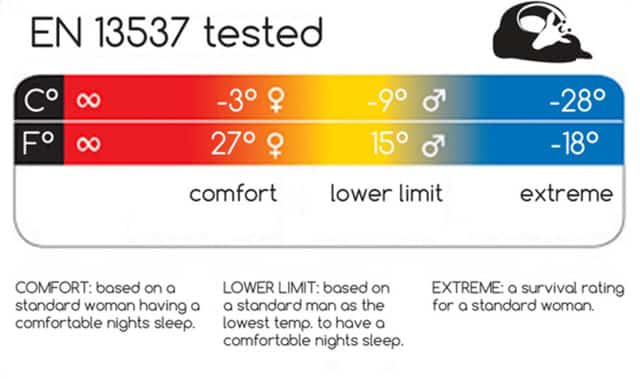
It can get colder than anticipated, especially in springtime or fall where the weather changes quickly. To make sure you don’t end up cold at night, choose a sleeping bag which has a comfort rating less than what you think the temperature will be.
For example: If you expect the nighttime temperature to be 50F, then choose a bag with a comfort rating of 30-40F.
You’ll also need to factor in your individual comfort level. I’m apparently a cold sleeper. I’ve got a sleeping bag with a 25F comfort rating but still felt cold at 32F.
Pro Tip: Use a Sleeping Bag Liner
Sleeping bag liners are basically silk or nylon bags that you put inside your sleeping bag. A sleeping bag liner can add over 10 degrees F to your sleeping bag rating. How much it will add will depend on your bags initial rating: The lower the sleeping bag rating, the more the liner will add to it.
In addition to keeping you warm, liners are soft to sleep on and keep your sleeping bag clean. They are cheap to buy (at least cheaper than a new sleeping bag) and will give your sleeping bag a lot more range. Some travelers take to hostels to avoid bedbugs.
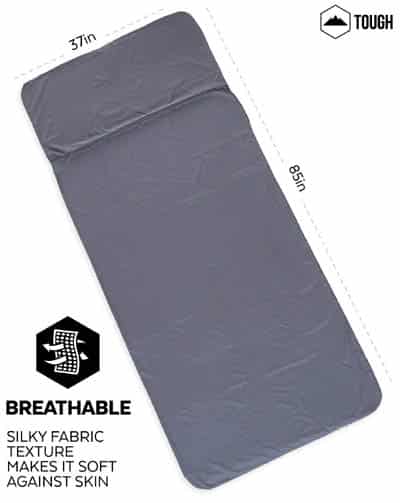
This sleeping bag liner by Tough Outdoors adds 5-10 degrees F to your sleeping bag. It is a very affordable option. You can buy it here.
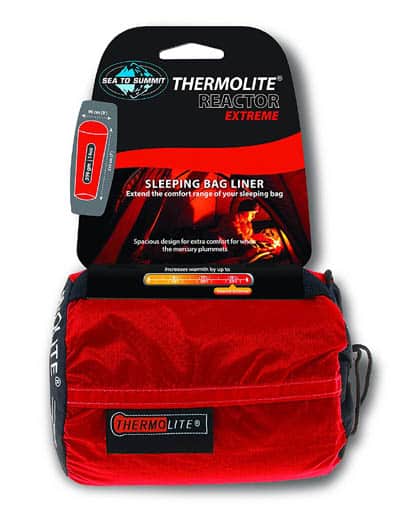
This sleeping bag liner is a bit heavier (14oz) and pricier, but adds up to 25F to your sleeping bag rating. Buy it here at REI or on Amazon.
Also read:
- How to Sleep Warmer in Your Sleeping Bag (Regardless of Its Rating)
- Can You Sleep in Two Sleeping Bags?
3. Sleeping Pads
If you don’t have a good sleeping pad, the ground will literally suck the heat out of your body (for us science nerds, this is referred to as conductive heat loss). Even if you have a warm sleeping bag, you will still end up cold at night.
Sleeping pads are rated in R-value, which refers how much the pad can Resist heat flow. The higher the R-value, the better the pad will insulate you from the ground. As a general rule, you need an R-value of 2-3 for cold weather camping.
Here are tips for getting the right sleeping pad:
- Choose the highest R-value: Sleeping pads are rated in R-value. Choose the highest R-value you reasonably can. If you are backpacking, you’ll be limited because high R-value pads are heavier. But it is worth carrying a few more ounces to get extra comfort!!!
- R-value is accumulative: High R-value sleeping pads can be very expensive. If you are on a limited budget, you can use one pad on top of another to make it warmer. For example, a pad with an R-value of 1 on a pad with an R-value of 2.5 will give an accumulative insulation of R-3.5.
- Do NOT use a pump-type air mattress: Air mattresses might be comfortable, but they are heat sinks. The exception is if the air mattress is insulated, such as these options.
The Therm-a-Rest NeoAir Xlite is one of the best backpacking sleeping pads. It has an R-value of 3.2 and only weighs 12 ounces. It’s a bit pricy though. If you want something cheaper but nearly as good, check out these affordable Therm-a-Rest alternatives.
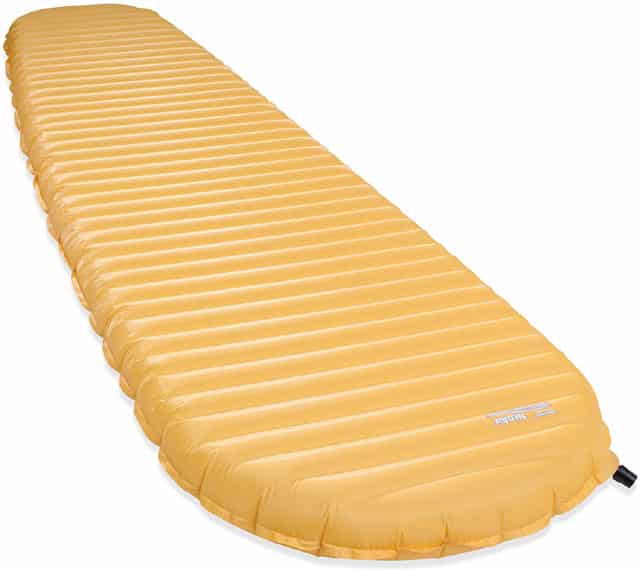
The Therm-a-Rest NeoAir Xlite is one of the best lightweight sleeping pads for 3 season weather, but it’s pricy! Buy it here.
4. Clothing which Won’t Make You Sweat
You probably know that you need to wear layers of clothes to stay warm when camping. But layering doesn’t mean you should keep addings more layers when you get cold! It is combining clothing in a smart way.
The three layers of clothing you need for cold weather camping are:
- Base layer: This must be a synthetic material or wool. It’s job is to wick moisture away from your body so you don’t end up sweaty (and thus cold). Never wear cotton base layers as they absorb moisture like a sponge.
- Mid layer: This is your insulating layer. It should be big and fluffy. Fleece hoodies work well in mild weather. In very cold weather, you will want a puffy jacket or thick wool sweater. In very cold weather, you may want two mid layers. You’ll also need a mid layer on your legs, like fleece pants.
- Shell layer: The shell layer is what protects you from rain. It also ensures that the heat from your mid layer doesn’t get blown away from wind.
Layering Applies to Pajamas Too!
You’ll need a clean, dry base layer to wear as your pajamas. The sleeping bag acts as the mid layer and the tent as your shell layer. Don’t try to sleep in cotton pajamas as you can end up wet from sweat.
Read: Best Merino wool base layers
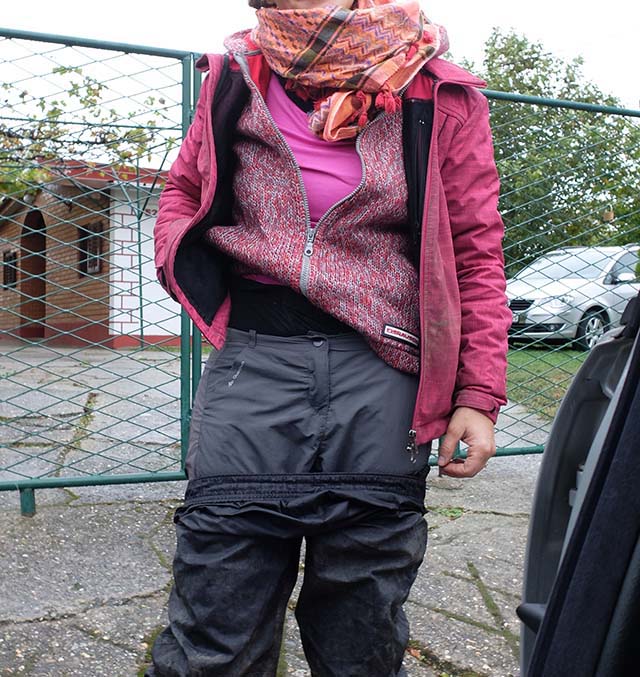
Check out all the layers I wore for a camping trip in rainy 40F (daytime) weather! I was toasty warm 😀
The Importance of Staying Dry when Camping in the Cold
One of the biggest challenges when camping in the cold weather is staying dry. You can easily end up wet if it rains (which is likely in spring and fall). As mentioned before, condensation is also a big problem when camping in cold weather. If it forms in your tent, it can drip on your gear.
Getting wet can be VERY dangerous.
When you get wet, the water will start evaporating off of your skin, causing your body temperature to decrease. This is why hypothermia can occur even in temperatures as high as 60 degrees F! (Source)
To stay dry, you’ll need:
- A waterproof jacket and pants. It’s rather pointless to have a rain jacket if your pants just get wet! These are my top picks for rain pants for women and kids.
- Tarp shelter. This is very useful because it gives you somewhere to hang out while it rains. You can also keep gear there so it doesn’t get wet, or so you don’t have to bring wet gear into the tent (which will make condensation worse). For more info, read 27 Ways to Set Up a Tarp Shelter.
You’ll need some know-how. Please read:
- Important Tips for Camping in the Rain
- What to Wear for Camping in Cold, Rainy Weather
- How to Pitch a Tent in the Rain so the Inside Doesn’t Get Wet
- 27 Ways to Set Up a Tarp Shelter (with pictures)
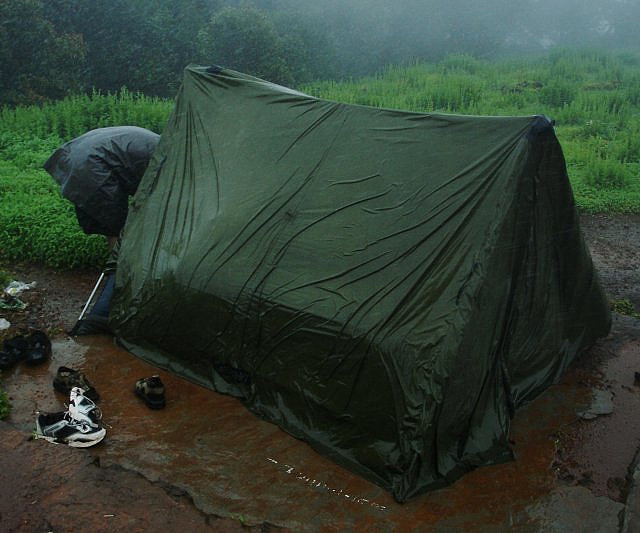
This tent was set up incorrectly and became flooded in the rain! These campers are going to be freezing their butts off. :/
How Cold Will It Get Camping?
A big mistake that many amateur campers make is not forecasting temperatures properly. Then, it ends up being a LOT colder than they anticipated, making for a miserable camping trip. To prevent this, use these steps to accurately calculate temperatures.
1. Find the Forecast for the Nearest Weather Station
When you check the forecast for a campground, you get the forecast for the nearest weather station. Sometimes that weather station isn’t actually located near the campground! This means the forecast can be wildly inaccurate.
To get a more accurate forecast, use:
- Mountain-forecast.com: It gives you live temperatures at different elevations of mountains.
- NOAA zone weather forecasts: Just click on the map where you are going and it will give you a forecast for that specific area.
2. Adjust Forecast Based on Elevation
There is less air at higher elevation, which means that the air can’t trap as much heat. Thus, it is colder at higher elevations than at lower elevations. This is important because your campground may be at a higher elevation than the nearest weather station.
For example, most forecasts for the Smoky Mountains are based on Gatlinburg, TN which is only 1,200 feet in elevation. The highest campground in the Smoky Mountains is at over 5,000 feet. That’s a huge difference in elevation and thus a big temperature difference.
To get an accurate forecast based on elevation:
- Get the forecast for the nearest weather station.
- Find the elevation of the weather station and your campground.
- Calculate the difference between the two elevations.
- Adjust the temperature forecast.
- When there is no snow or rain, temperature decreases approximately 5.4°F for every 1000 feet in elevation (9.8°C for every 1000 meters in elevation).
- If there is snow, rain, or you are in a cloud, temperature decreases approximately 3.3°F for every 1000 feet (6°C for every 1000 meters).
For example, look at the screenshot below. It shows daytime temperatures of Yosemite’s Grizzly Peak in November. There is a 20F temperature difference between the high and low elevation areas of the peak.
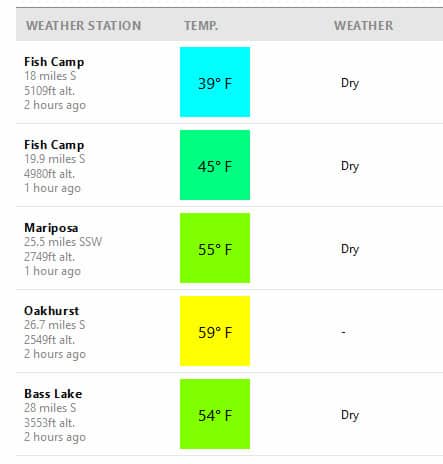
3. Factor in Daytime vs. Nighttime Temperatures
At low elevations, the difference between highs/lows isn’t too much. But, at high elevations, there can be a huge difference. It can be scorching hot during the day and freezing cold at night.
For example, at Grant Village Campground (7,800 feet) in Yellowstone, summertime temperatures are usually in the 70s/80s but can drop to 30s/40s at night. It’s even snowed on July 4th there!
Here are some temperature ranges to give you an idea of how much temperature can drop at night:
- Rocky Mountains: Summer temperatures in the high 90s during the day and 60s and 70s and night
- Yellowstone National Park: Summer temperatures are in the 70s during the day and drop to below freezing at night in higher elevations. In spring and fall, temperatures are in the 30s to 60s during the day and drop to teens or single digits at night.
- Zion National Park: During the spring and fall, temperatures are up to 90F. At night, the temperature can differ by over 30 degrees.
- Grand Canyon, South Rim: Summer temperatures are usually in the 80s during the day and 40s/50s at night.
- Yosemite National Park: In summer, daytime temperatures are in the high 80s and drop to the 50s at night. In fall, daytime temperatures are in the 50s to 70s and drop to the 30s/40s at night. (source – nps)
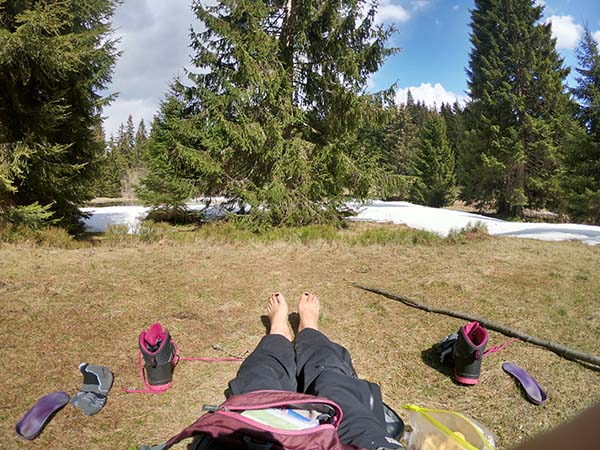
Airing my feet during an April camping trip at 3,000ft (900m) elevation. It was warm during the day but dropped to below freezing at night!
4. Plan for Sudden Weather Changes
Weather in fall and spring can be unpredictable, especially at higher elevations. It can be very warm one day only to drop to frigid temperatures the next.
Take a look at the screenshot below from Wunderground of Colorado Springs (elevation 6,000 ft). It went from a low of 57F on Sept 7th to a literal freezing 31 degrees F on the next day. This could create a miserable – or even dangerous – camping experience for anyone who wasn’t prepared.
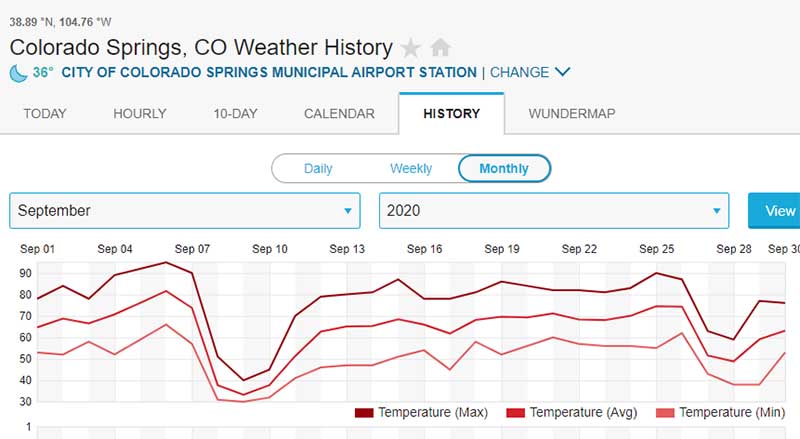
Because of these drastic temperature changes in spring an fall, you’ll need to plan for summer and winter. You’ll need things like UV protection and warm-weather clothes, but also a good mid-layer and outer shell in case it gets colder than expected.
Camping in 20 vs. 30 vs. 40 Degree Weather
40 Degrees
Camping with nighttime temperatures in the low 40s is when you will really start feeling the cold. At these temps, you can get away with having mediocre gear and clothes – but you’ll need to have skills. For example, skills like knowing how to build a fire in wet conditions or choosing a good campsite become even more important.
30 Degrees
When temperatures get into the 30s, you’ll need better gear. Or, if you don’t mind lugging around a lot of extra gear, you can double up: use two sleeping pads and two sleeping bags.
The main risk with camping at nighttime temperatures in the 30s is that you may get wet. Even if it doesn’t rain, condensation will form inside the tent, potentially causing your gear to get wet.
At these temps, skills are important. If you don’t know how to prevent condensation or keep your gear dry, bring LOTS of extra warm clothes as backups.
20 Degrees
When camping at 20 degree weather, things start to get very uncomfortable. Heck, even your FACE ends up feeling cold at night. At these temps, you might consider a tent heater.
I wouldn’t want to take young kids camping in this cold (especially my daughter who complains about having to wear her “dorky” clothes, but that’s another issue…).
On the flip side, there are a lot fewer campers out when the weather gets this cold. You’ll have popular campsites all to yourself and the snow-covered peaks can be beautiful.
But don’t rush it: Practice camping at warmer temperatures first before you test your gear (and endurance) at 20 degrees.
Tips for Camping in the Cold
Choose a Campground Where You Can Make a Fire
Campfires are great for keeping you warm at the campsite until it’s time to crawl into your sleeping bag. But campfires aren’t always allowed. Or you may be required to bring a portable campfire pit if you want to make a fire.
Bear in mind that you also need to know how to make a fire. It isn’t always easy when everything is wet or you have limited wood! Make sure you read: How to make a campfire and 5 fire lays every camper needs to know.
Avoid Sleeping Bag Mistakes
Any of these mistakes could also make it too cold to go camping, despite having a bag rated for cold weather.
- Not fluffing a down sleeping bag: Down sleeping bags are usually rated for very cold weather. However, they only provide insulation if the down feathers are fluffy. If you use a down bag straight from the compression sack, the feathers will be scrunched together and won’t provide insulation. Thus, you have to fluff a down bag before using.
- Sleeping with your head inside the sleeping bag: If it is cold while camping, your first reaction might be to put your head inside the sleeping bag. But this will cause vapor from your breath to get into the bag. Even a slight amount of moisture will cause you to feel cold! If your head is cold, put on a hat instead.
- Choosing a sleeping bag which is too warm: While it is smart to err on the side of caution when choosing a sleeping bag, don’t go crazy and use a 0F bag in 40F weather. You will end up sweating a lot at night. The sweat will cause you to get very cold while sleeping.
- Using an adult sleeping bag for children: The extra room means that the sleeping bag won’t trap warmth as well. Buy a child-sized sleeping bag for your kids. See this list of the best kids sleeping bags.
Be Cautious When Using the Hot Water Bottle Trick
A lot of websites recommend filling an un-insulated water bottle with hot water, then putting it in your sleeping bag.
This will heat up your sleeping bag, but it is also dangerous. What if the water bottle leaks? Your sleeping bag – which is supposed to keep you alive – is not wet!
If you are going to try this, then be extra cautious. Make sure the bottle won’t leak and still wrap it in a towel in case it does.
Cooking At Below Freezing Weather
Bear in mind that isobutane camping stoves don’t work well in below freezing weather. You’ll want to switch to liquid white gas, which performs better in the cold.
No matter how cold it gets, NEVER COOK IN YOUR TENT. You can end up dying from carbon monoxide poisoning.
Bring Extra Calories
Make sure you pack a lot more food than you normally would camping when it’s cold. You can use this calculator to get an idea of how many calories to bring.
Don’t Sit on the Ground
Sitting on the cold ground will suck the heat from your body. Bring chairs or a closed-cell foam pad to sit on. It will also keep your butt dry.
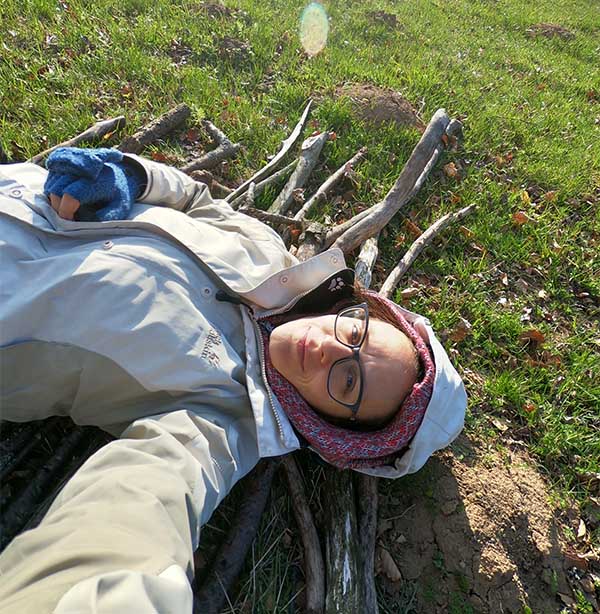
I felt like taking a nap outside but didn’t want my sleeping pad to get wet. So I made a “bed” out of sticks. The sticks kept me off the cold ground so I stayed warm!
Orient Tent towards Sun
When setting up camp, pay attention to which direction the sun will rise. Make sure your tent will get the morning sun. It goes a long way to thawing frost and warming you up in the cold morning.
Go to the Bathroom before Sleeping
There is a myth that a full bladder will make you warmer. There’s no truth to this! Make sure you go to the bathroom before bed. Otherwise you’ll have to crawl out of your warm sleeping bag in the cold night.
Beware of Condensation
Even if you vent your tent, condensation can still form inside on very cold nights camping. The condensation can soak your gear. Keep all your gear covered with garbage bags or your backpack cover so it doesn’t get wet.
Not sure what to eat while camping?
I’ve written an eBook with over 50 dehydrator backpacking recipes. They pack down to lightweight and you just add water to rehydrate. Plus, there’s tons of info on meal planning and nutrition for backpacking. Learn more here.
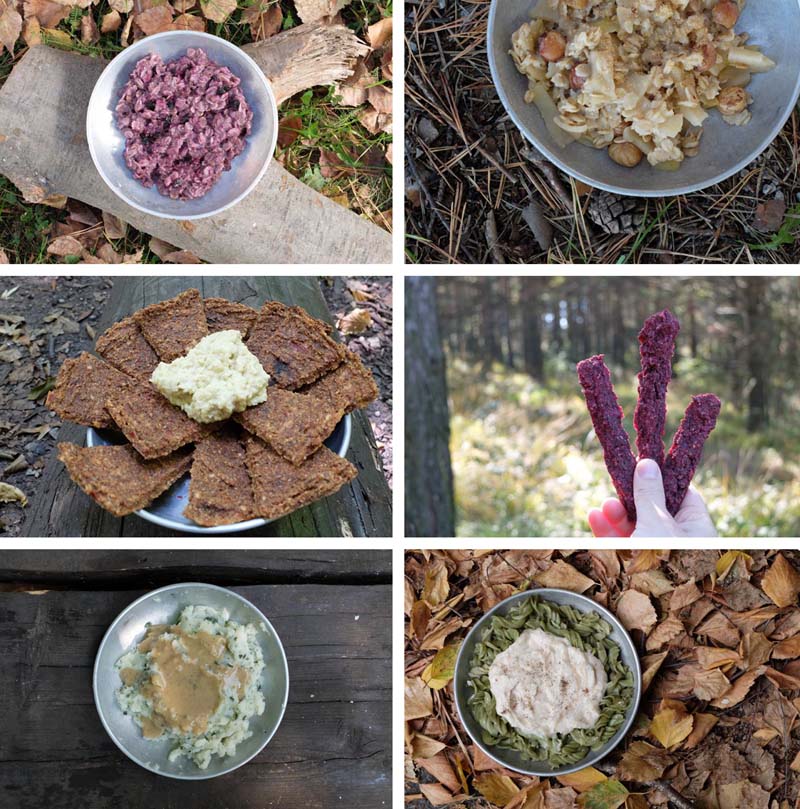
These are the types of meals I’m eating when I backpack. They pack in over 130 calories per ounce dry weight. Just add water to rehydrate!
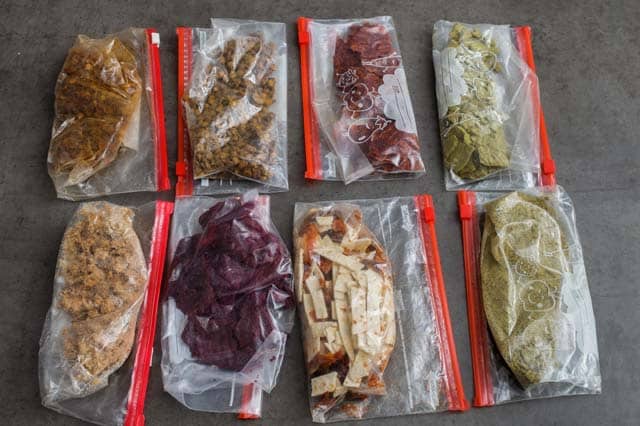
These meals have 13,700 calories and only weigh 6.9lbs dry. Just add water to rehydrate!
Ready to step up your trail food? Buy the ebook. I’ll even give you 50% off!
Image credits:
Thejaswi I Our tent CC BY SA 2.0,
“Mt. Olympos” (CC BY-NC 2.0) by teo de pap,
“Frosted Tent” (CC BY-NC-SA 2.0) by bartt,
Resources:
https://www.outdoorindustry.org/pdf/EN13537Mccullough062209.pdf,
https://www.quora.com/Is-14-degrees-Celsius-a-good-temperature-for-camping


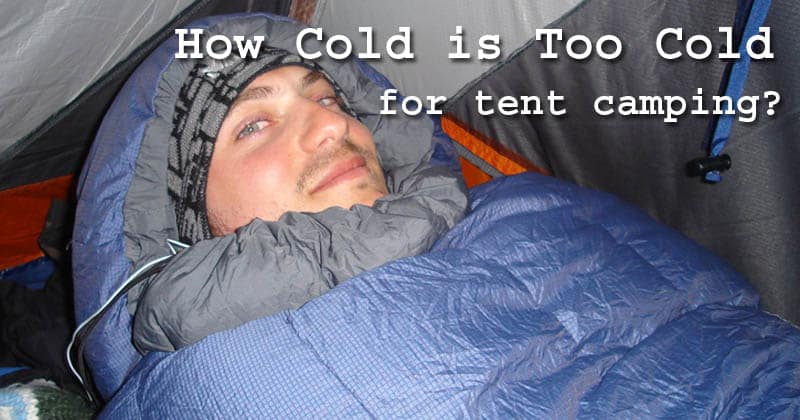
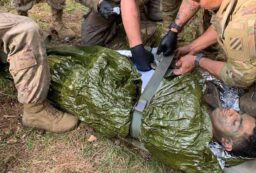
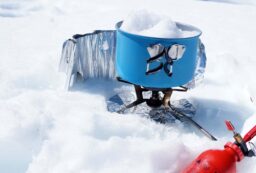
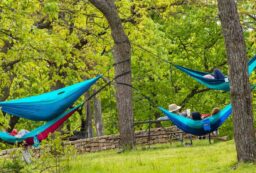







6 Comments
Patrick
December 15, 2020 at 8:57 pmNice article. I camped in around 38 F last night about 150 feet elevation, layered up with lots of thin clothes… didn’t know the sleeping bag liner made such a huge difference but it helped. My knees were still cold though after everything. Didn’t knock out long and steady, just 4 or 5 bouts of half-asleep episodes, caught a few dreams though.
Diane
December 16, 2020 at 1:59 pmI’ve had a cold back, face and feet before but have yet to get cold knees when camping 🙂
Matt
January 18, 2021 at 3:32 pm30-40 is too cold? Really?
When we were kids with “amateur” gear we camped in 15 degree weather all the time. I know plenty of people that camp in -20 weather.
Diane
January 18, 2021 at 4:14 pmI guess it depends on what you consider amateur gear. For most people (at least by what I’ve seen at campgrounds), it’s those cheap summertime sleeping bags which sometimes don’t even have a proper rating. And a lot of people use single-wall tents which start having terrible condensation problems around 40 degrees, so they end up getting dripping wet. 🙂
Richard
April 22, 2021 at 3:35 amGreat pointers & items to consider – thanks!
Jess
February 7, 2022 at 2:54 amI love your dehydrated food tips. My partner and I are planning to do the AT with our son and the dehydrated meals will be perfect for meal planning ahead of time! Thanks for sharing!